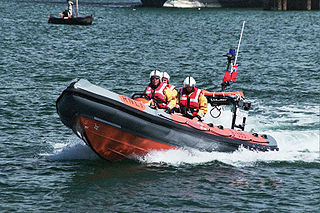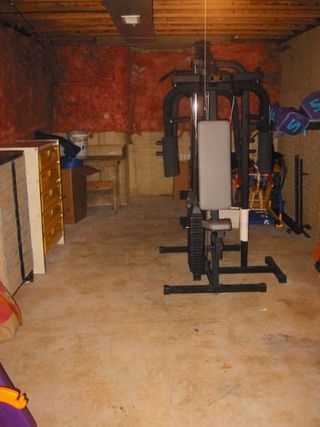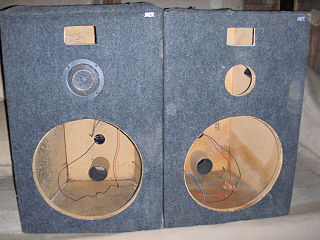
A dorade box (also called a dorade vent, collector box, cowl vent, or simply a "ventilator") is a type of vent that permits the passage of air in and out of the cabin or engine room of a boat while keeping rain, spray, and sea wash out.

A dorade box (also called a dorade vent, collector box, cowl vent, or simply a "ventilator") is a type of vent that permits the passage of air in and out of the cabin or engine room of a boat while keeping rain, spray, and sea wash out.
The basic form is a low, rectangular box fixed to the deck or cabin top, fitted with interleaving vertical baffles. The baffles alternate to be free at the floor of the box, or free at the ceiling, forming a series of chambers.
A horn-shaped ventilation cowl is usually fitted facing forward to a large hole at the top of the chamber at one end of the box with another large hole opening down into the boat from the chamber at the other end. Limber holes perforate the wall of the box at the floor of each chamber.
Dorade boxes operate on the principle that air can pass relatively freely through the chambers, yet rain or sea wash will be trapped in successive chambers and drain out of the small holes in the sides of the box.
The principle can be applied to other forms. For example, one variant has a circular layout with the baffles as concentric rings.
The first appearance of Dorade boxes was on the Olin Stephens-designed Dorade , a yacht built in 1929 for ocean racing. [1] As originally built, the Dorade's vents led directly below, but this was found to allow water below, and the vents were modified in the early 1930s.

A rigid inflatable boat (RIB), also rigid-hull inflatable boat or rigid-hulled inflatable boat (RHIB), is a lightweight but high-performance and high-capacity boat constructed with a rigid hull bottom joined to side-forming air tubes that are inflated with air to a high pressure so as to give the sides resilient rigidity along the boat's topsides. The design is stable, light, fast and seaworthy. The inflated collar acts as a life jacket, ensuring that the vessel retains its buoyancy, even if the boat is taking on water. The RIB is an evolutionary development of the inflatable boat with a rubberized fabric bottom that is stiffened with flat boards within the collar to form the deck or floor of the boat.

A basement or cellar is one or more floors of a building that are completely or partly below the ground floor. It generally is used as a utility space for a building, where such items as the furnace, water heater, breaker panel or fuse box, car park, and air-conditioning system are located; so also are amenities such as the electrical system and cable television distribution point. In cities with high property prices, such as London, basements are often fitted out to a high standard and used as living space.
An uncontrolled decompression is an undesired drop in the pressure of a sealed system, such as an aircraft cabin or hyperbaric chamber, that typically results from human error, structural failure, or impact, causing the pressurised vessel to vent into its surroundings or fail to pressurize at all.
A bass reflex system is a type of loudspeaker enclosure that uses a port (hole) or vent cut into the cabinet and a section of tubing or pipe affixed to the port. This port enables the sound from the rear side of the diaphragm to increase the efficiency of the system at low frequencies as compared to a typical sealed- or closed-box loudspeaker or an infinite baffle mounting.

A loudspeaker enclosure or loudspeaker cabinet is an enclosure in which speaker drivers and associated electronic hardware, such as crossover circuits and, in some cases, power amplifiers, are mounted. Enclosures may range in design from simple, homemade DIY rectangular particleboard boxes to very complex, expensive computer-designed hi-fi cabinets that incorporate composite materials, internal baffles, horns, bass reflex ports and acoustic insulation. Loudspeaker enclosures range in size from small "bookshelf" speaker cabinets with 4-inch (10 cm) woofers and small tweeters designed for listening to music with a hi-fi system in a private home to huge, heavy subwoofer enclosures with multiple 18-inch (46 cm) or even 21-inch (53 cm) speakers in huge enclosures which are designed for use in stadium concert sound reinforcement systems for rock music concerts.

An evacuation slide is an inflatable slide used to evacuate an aircraft quickly. An escape slide is required on all commercial aircraft where the door sill height is such that, in the event of an evacuation, passengers would be unable to step down from the door uninjured.

The Bayfield 30/32 is a Canadian sailboat, that was designed by Ted Gozzard as a cruising boat and first built in 1973.
The C&C Landfall 39 is a sailboat that was designed by C&C Design and Robert Perry and first built in 1985. The boat has a centre cockpit deck layout, which allows for an aft cabin interior.
The Landfall 43 is a Canadian sailboat that was designed by Robert W. Ball, the chief designer of C&C Design, and first built in 1982. The Landfall 43 was built with the charter trade in mind, to compete with Morgan and Whitby’s centre cockpit models. The Landfall series, begun with the Landfall 43's predecessor the Landfall 42, was part of a trend within C&C Yachts during the later 1970s and early 1980s to develop more cruising-oriented designs under company president George Cuthbertson's direction.
The Landfall 48 is a sailboat that was designed by C&C Design and first built in 1980. The Landfall series, begun with the Landfall 42, was part of a trend within C&C Yachts to develop more cruising-oriented designs under company president George Cuthbertson's direction during the later 1970s and early 1980s.
The Hunter 320 is an American sailboat that was designed by the Hunter Design Team and first built in 2000.
The Hunter 340 is an American sailboat that was designed by the Hunter Design Team as cruising sailboat and first built in 1997.
The Seafarer 30, also known as the Seafarer Swiftsure 30, is an American sailboat that was designed by McCurdy & Rhodes as a cruiser-racer and first built in 1978.
The Southern Cross 28, also called the Gillmer 28, is an American sailboat that was designed by Thomas C. Gillmer and first built in 1978.
The Coast 34 is a Canadian sailboat that was designed by Bruce Roberts and Grahame Shannon as a cruiser and first built in 1980.
The Nimbus 42 is a Swedish sailboat that was designed by Americans F. Michael Kaufman and Robert Ladd as a cruiser-racer and first built in 1981.
The S2 35 is an American sailboat that was designed by Graham & Schlageter as a cruiser. The design is also referred to as the S2 35C for "center cockpit", although there was no other configuration model built. At its introduction in 1986, S2 Yachts marketed the boat as the S2 35 Mid Cockpit.
The Seaward Fox is an American trailerable sailboat that was designed by Nick Hake as a pocket cruiser and first built in 1993.
The Vancouver 25 is a Canadian trailerable sailboat that was designed by Robert B. Harris as a blue water cruiser and first built in 1983.

The Little Harbor 44 is an American sailboat that was designed by Ted Hood and first built in 1983.